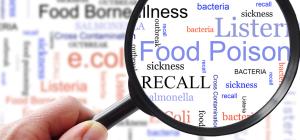
Foodborne illness outbreaks: Roles and responsibilities

Key Messages |
|
Introduction
Annually, foodborne diseases have been estimated to affect more than 550 million people and cause 230,000 deaths globally.1 These estimates are considered conservative due to significant underreporting. Further, outbreaks cause major losses due to restrictions on trade and the sale of food products.2 The globalization of the food supply has resulted in the daily movement of large volumes of food across domestic and international borders.3 Increasing evidence for the transboundary nature of foodborne pathogens4 poses an additional challenge for food safety, and highlights a growing need for international collaboration and data sharing for surveillance and outbreak investigation.2 The rapidly changing food system, especially the rise in e-commerce and food delivery programs, adds additional risks and complexities. Lastly, affected communities are rarely consulted and often ill-informed during a conventional outbreak response, posing a detriment to investigative and mitigation success.5
Rapid and accurate detection and subsequent investigation of the source of foodborne outbreaks is essential to limit illness and avoid unnecessary restrictions on falsely implicated foods and establishments.2 Foodborne illness outbreak detection, investigation, and response require close collaboration and coordination within an interdisciplinary team and in partnership with various levels of government.6 In Canada, response to foodborne outbreaks can involve several organizations at multiple levels of government with complementary (and sometimes overlapping) responsibilities.3
Environmental public health professionals (EPHPs, commonly known as public health inspectors and environmental health officers) play an essential role in foodborne outbreak investigations. However, some EPHPs, especially those new to the field of practice, may lack formal training and experience in outbreak response.7 EPHPs are often first responders in the case of a foodborne outbreak and can bring unique skillsets and competencies to outbreak investigations. This report examines foodborne outbreaks focussing on the roles and responsibilities of EPHPs in different foodborne outbreak categories.
This is the second of three documents developed to provide guidance on the collaborative investigation of foodborne outbreaks and it introduces the use of a RACI (Responsible, Accountable, Supporting, Consulted, and Informed) chart for foodborne outbreak response. A RACI chart is commonly used in project management.
The findings of this report and the accompanying responsibility matrix (RACI) template (Supplement A) are intended to complement the following existing outbreak tools and publications:
- National Collaborating Centre for Infectious Diseases outbreak toolkit, offering a one-stop resource for epidemiologists, EPHPs, public health nurses, and other practitioners involved in enteric outbreak response.8
- Canada’s Foodborne Illness Outbreak Response Protocol (FIORP), which offers a guide to multi-jurisdictional enteric outbreak response.3
- Canada’s Weight of Evidence: Factors to Consider for Appropriate and Timely Action in a Foodborne Illness Outbreak Investigation. This document was developed in response to the Canadian deli-meat listeriosis outbreak in 2008, to examine and determine recommendations for the type of evidence necessary and sufficient to take various outbreak mitigation actions.9
- Ontario’s Public Health Inspector's (PHI) Guide to Environmental Microbiology Laboratory Testing is an evergreen guide created by Public Health Ontario, which is designed to support effective public health practice, ensuring that EPHPs have timely information on laboratory environmental microbiology services and expertise.10
- International Association for Food Protection’s Procedures to Investigate Foodborne Illness guide, provides a universal outbreak guide for epidemiological, environmental health assessment, and laboratory investigations.6
Information and resources presented may be useful for local public health and practicing EPHPs to support foodborne outbreak response and meet professional development needs.
Methodology
The purpose of this study was to gain a better understanding of the roles and responsibilities of EPHPs in foodborne outbreak response. First, an environmental scan was conducted for federal, territorial, and provincial public health websites, as well as a selection of foodborne outbreak-related websites from the United States and World Health Organization. The environmental scan was used to identify different classifications of foodborne outbreaks and to enhance the roles and responsibilities identified in the National Collaborating Centre for Infectious Diseases Outbreak Toolkit,8 applying a project management lens. The environmental scan also included a literature review focussed on public health outbreak roles and responsibilities, recent foodborne outbreaks in Canada, and core competencies for foodborne outbreak response. Scholarly articles, grey literature, and government websites were searched for information on foodborne outbreak roles, responsibilities, and competencies, using PubMed, CINAHL, Food Science Source, Google Scholar, and Google databases. Search strategies were adjusted for each platform’s specific format. Relevant English-language results were collected from January 2010 to December 2022. Complete search terms and the full list of results are available upon request.
Second, 14 surveys and 20 semi-structured key informant interviews (KIIs) were conducted. A phenomenological approach,11 within a constructivist paradigm12 was used to understand participants’ foodborne outbreak experiences. The survey focussed on clarifying outbreak roles and responsibilities across outbreak categories, and the identification of outbreak tools and resources. While the KIIs sought to gain insight into foodborne outbreak experiences and identify themes (challenges and opportunities) related to foodborne outbreak response, they were conducted with a selection of public health professionals from federal, provincial, and local health authorities experienced in outbreak investigations, and continued until no new themes were identified.13
Survey respondents and key informants were recruited at the Canadian Institute of Public Health Inspectors (CIPHI) National Annual Education Conference, followed by a promotional campaign through the NCCEH September newsletter, CIPHI National listserv, and via snowball sampling.14 Interested experts submitted their name and contact information via Microsoft Forms. KII’s were conducted via Zoom, between October 21 and January 7, 2023.
Results
Foodborne outbreak categories, roles, and responsibilities
The environmental scan of public health websites was used to identify EPHP roles and professional competencies related to foodborne outbreak response. Competencies for EPHPs in foodborne illness outbreak detection, investigation, and response are presented in Table 1 (see Appendix A). Outbreak roles and responsibilities are presented in the RACI chart (see Supplement A - RACI Chart for Foodborne Illness Outbreaks, available as a separate downloadable Excel file). The environmental scan and a review of recent outbreaks was used to develop the four categories of outbreaks:
- Local—single jurisdiction
- Local—multijurisdiction
- Interprovincial
- International
The applicability of the four categories and breadth of EPHP outbreak experiences across the categories was confirmed through the KIIs. Descriptions for each category, along with examples, are provided in the discussion section. Based on the findings from the survey (n=14) EPHPs have more experience in local outbreaks than international (see Figure 1). Further, EPHPs’ roles and responsibilities vary across the four categories (see Figure 2).
EPHP outbreak experiences—an emerging need
Most respondents reported being more involved in the three phases of outbreak investigation (environmental, epidemiology, and laboratory) for local outbreaks compared with multijurisdictional, interprovincial, and international outbreaks. Reported experiences decreased for interprovincial and international outbreaks, with 7 out of 14 respondents indicating no regular experience with international outbreaks. Several EPHPs reported working for health authorities where environmental health (e.g., inspection and sample collection) and communicable disease (e.g., case follow-ups) responsibilities are completed by different groups of EPHPs.
The lack of experience, particularly with environmental assessments (versus compliance inspections) and interviews, was identified through the KIIs as a key theme for development and education of early career EPHPs. Additionally, several KIIs noted a recent loss of outbreak expertise due to staff turnover linked to retirements and COVID-19.
Figure 1. Self-reported experience in the three phases of outbreak response (environmental, epidemiology, and laboratory) for local outbreaks compared with multijurisdictional.
NOTE: The number of responses for Environmental is based on the most reported experience from the survey questions: Environmental assessment (aka premise inspection), Enforcement actions, and Implementation of outbreak control measures. Epidemiology is from Case and contact follow-up, Data analysis, and Interpretation of outbreak data. Laboratory is based on responses for being involved in Sample collection.
Figure 2. Self-reported roles during the four categories of foodborne outbreaks.
Additional outbreak roles and responsibilities
Additional EPHP roles identified through the survey and KIIs included:
- Creating outbreak questionnaires and databases for response entry;
- Providing education to facility staff and operators;
- Participating in outbreak management coordinating committees;
- Participating in outbreak debriefs;
- Consulting with provincial and federal partners;
- Writing reports;
- Providing media releases and interviewing;
- Updating internal policies and procedures;
- Developing tools for case management;
- Conducting relevant training for colleagues; and
- Assisting with food recalls.
Responsibility matrix (RACI) to support outbreak response
These findings were used to create a RACI (Responsible, Accountable, Consulted, and Informed) responsibility matrix template that can be adapted to specific outbreak responses and various organizational roles and responsibilities. The RACI template was organized by the three main aspects of outbreak investigation (environmental, epidemiology, and laboratory) as well as post-outbreak activities including debriefs, outbreak summaries, and lessons learned.
Why RACI
A RACI chart was chosen for this project because it is a simple format that can easily expand on existing foodborne outbreak resources and tools. Foodborne outbreak guidance documents stress the importance of communication and coordination for foodborne outbreak response.3,6,8 Further, two KIIs indicated experience with RACI charts, one for emergency preparedness and one for working on a draft for local foodborne outbreak responses. Nova Scotia’s Outbreak Response Plan includes a responsibility matrix that identifies responsibility and accountably for different outbreak functions.15 The majority of KIIs expressed that although the principles of RACI are often informally followed, they do not have a formal tool. KIIs also identified that foodborne outbreak response often fails to ensure that key stakeholders are consulted and informed as needed.
Outbreak roles and responsibilities—RACI chart
A RACI chart is a type of responsibility assignment matrix (RAM) commonly used in project management.16,17 In practice, it is a table that lists all stakeholders on a project, in this case outbreak response. A RACI chart with a list of the most common outbreak roles and responsibilities is available as a separate downloadable Excel file (Supplement A). Roles and responsibilities are based on NCCID’s outbreak toolkit,8 IAFP Procedures to Investigate Foodborne Illness,6 findings from the literature search, and through the surveys and KIIs. The RACI tables are organized by environmental, epidemiology, and laboratory aspects of outbreak response. Additionally, a section has been added for post-outbreak responses.
RACI definitions
For each task, the stakeholder’s level of involvement should be denoted with the letters R, A, C, or I, which stand for:
- Responsible
- Accountable
- Consulted
- Informed
Here is what each designation means in the context of foodborne outbreak investigations16,17:
Responsible designates the task directly to this group or organization. This group does the work to complete the task or create the deliverable. Every task should have at least one responsible group but could have multiple responsible groups. This is common in multijurisdictional outbreaks with several groups conducting complementary work (e.g., environmental assessments at numerous food premises, manufacturers, and processors).
The accountable person or group delegates and reviews the work involved for a particular task. Their job is to make sure the responsible and consulting members know the expectations of their given tasks. Every task should have only one accountable group.
Consulted groups provide input and feedback on the work being done on a task. They have a stake in the outcomes of a task. Where possible, these stakeholders should be consulted ahead of starting a task to get input on their needs, and again throughout the work and at the completion of a task to get feedback on the outcome and impacts. Not every task needs a consulted party, but the outbreak coordinator should consider all possible stakeholders when creating the RACI chart and include as many consulted parties as is appropriate. In outbreak response, groups to consider consulting are food industries and vulnerable communities that may bear increased risks associated with the outbreak. An example is the First Nations groups impacted by the 2018 Vibrio cholerae outbreak in British Columbia.5
Informed groups need to be looped into the progress of a project but not consulted or overwhelmed with the details of tasks. They need to know what’s going on because it could affect them or their groups. In outbreak response there is a need to keep the public informed of the investigation and potential risks, often through the media.
Application of RACI to foodborne outbreaks
The RACI tool provided can be used and adapted to specific outbreaks. Organizations can add or delete tasks, as well as collaborators, based on the specific circumstances of the outbreak under investigation. For each outbreak, the lead organization can customize the RACI chart, using the codes to identify roles and responsibilities for each outbreak task. Samples of tasks have been included for demonstration purposes. A checklist column has been added, allowing for tracking of task completion.
Discussion
EPHP core competencies for foodborne outbreak response
EPHPs are critical to successful outbreak response because they are embedded in the local community, providing unique context and the understanding of the communities served. The depth and breadth of EPHPs roles will vary depending on the nature of the outbreak (local vs. international) and structure of the responding organizations.
Foodborne outbreak response requires an interdisciplinary team with expertise in microbiology, epidemiology, environmental public health, food science, and communication.18 The team may also benefit from expertise in veterinary medicine and enforcement, depending on the nature of the outbreak and suspected sources.18 There are three main phases of outbreak response: (1) environmental health; (2) epidemiology; and (3) laboratory.
EPHPs are trained and expected to maintain competencies in foodborne outbreak response,19 and they play pivotal roles in all three phases. To support this work, it is important that EPHPs demonstrate the required competencies to effectively aid in detection, investigation, and response.7,19 Table 1 (Appendix A) lists essential foodborne outbreak investigation competencies for EPHPs, based on the work by Torok et. al.,7 and the CIPHI Core Professional Competencies program.19 These competencies can be used by academia and public health authorities to evaluate the readiness of EPHPs to support foodborne disease outbreak investigations and identify training needs.
EPHPs are responsible for conducting environmental assessments at food facilities, and collaborating with epidemiologists, laboratorians, and other public health professionals to determine the cause of an outbreak and implement control measures.7 Unlike routine inspections that cover a range of potential food safety violations, outbreak environmental assessments focus on the factors contributing to the cause of the outbreak under investigation, and include inspection practices, sample collection, and food handler interviews.7 Further, EPHPs are routinely involved in case and contact follow-ups, especially in local outbreaks.20 EPHPs are often involved in environmental, food, and clinical sample collection and interpretation of results. They also have experience in progressive enforcement (“progressive enforcement” means using education visits/calls, inspections, warnings, and more stringent enforcement options to reflect the frequency and severity of noncompliance),21,22 an important skill in outbreak response and management.19
Examples of outbreak responses from local to international
1. Local—single jurisdiction
Most outbreaks that EPHPs will be involved in are at the local level, where affected individuals and potential sources are within a single jurisdiction or clustered among a few neighboring health units. Outbreak response and communication are led by the local health authority. EPHPs will often conduct environmental assessments and case interviews, and collect and interpret environmental, food, and clinical samples. Provincial and national support may be requested as the outbreak evolves if local capacity is overwhelmed or the scope of the outbreak expands to include additional health authorities, provinces, or international cases and sources.
The 2019 norovirus outbreak linked to a chain of Calgary restaurants is one example of a local jurisdiction response.23 Here, the Calgary region of Alberta Health Services coordinated and led the outbreak response, including case follow-ups, sample collection, and environmental assessments of the premise locations. Local outbreaks may also be more complex, including consultation and coordination with provincial partners,24 as occurred in the April 2021 Shiga toxin-producing Escherichia coli (E. coli) (STEC) O103 outbreak identified among patients at two hospitals in Victoria, British Columbia.24 In this outbreak, local EPHPs collected exposure information through case interviews and review of hospital menus, while federal and local public health authorities conducted an environmental assessment of the processing plant for the suspect source. All confirmed cases were inpatients or outpatients at two hospitals and were exposed to raw minced celery within prepared sandwiches provided by hospital food services. A local processor supplied the minced celery exclusively to the two hospitals.24
2. Local—multiple jurisdictions
Outbreaks often evolve to encompass more than one health authority within the same province. Responsibility for the outbreak response may vary depending on the scope of the outbreak, number of cases, clustering of cases, and suspected source. In these cases, coordination between local health authorities and communication with provincial partners is paramount. EPHPs continue to be heavily involved in the response, conducting environmental assessments and case interviews, and collecting and interpreting environmental, food, and clinical samples. Sharing of data between health units and provincial or federal authorities plays an important role in coordinating responses and implementing control factors.
The 2005 community outbreak of travel-acquired Hepatitis A transmitted by an infected food handler in Waterloo Region, Ontario, is a good example of a locally led outbreak investigation that involved cases in additional jurisdictions and required support, communication, and coordination with public health professionals at the provincial and federal levels.25 In this case, outbreak coordination responsibility remained with the local level.
3. Interprovincial
The next level of complexity for outbreak response involves cases and sources across more than one province. Here, the Public Health Agency of Canada (PHAC) routinely takes a lead role in the coordination and communication of the outbreak response.3 Under the coordination provided by PHAC, local EPHPs are routinely involved in the epidemiology, environmental health assessments, and collection of food, environmental, and clinical samples. EPHPs will also interview cases and controls using standardized questionnaires.
The investigation at this stage requires significant coordination between local, provincial, and federal partners. Environmental assessments are often coordinated efforts between local and provincial or federal food safety authorities, based on the type of food premise and commodity suspected.
A recent example is the Salmonella outbreak linked to frozen corn kernels, involving five provinces: British Columbia, Alberta, Saskatchewan, Manitoba, and Ontario.26 PHAC collaborated with provincial public health partners, the Canadian Food Inspection Agency (CFIA), and Health Canada to investigate this outbreak. The recalled products were known to have been distributed in five provinces, but may have been distributed in other provinces and territories. This led to several secondary recalls being issued for products that were made using the recalled frozen whole kernel corn. The recalling of products is yet another role where EPHPs may be responsible for or support the removal of affected products.
4. International
International outbreaks represent the most complex outbreak response, requiring coordination and timely communication within Canada (local, provincial, and national) and with public health and food safety partners in other countries. The globalization of the food supply has resulted in the daily movement of large volumes of food and subsequent increasing evidence for the transboundary nature of foodborne pathogens, signalling a growing need for international communication and collaboration in foodborne illness outbreak detection, investigation, and response. Given these trends, the frequency and scope of international outbreaks is anticipated to increase.
An example is the collaborative investigative efforts of US and Canadian public health officials during the 2013–2014 international outbreak of multiple Salmonella serotype infections linked to sprouted chia seed powder.27 The investigation included open-ended interviews of ill persons, trace-back, product testing, facility inspections, and trace-forward. Cases reported consuming one of thirteen different brands of chia seed powder that traced back to a single Canadian firm, distributed by four US and eight Canadian companies. Laboratory testing yielded outbreak strains from leftover and intact product, triggering various product recalls.
Post-outbreak response—closing the loop and sharing lessons learned
Post-outbreak activities, including debriefs or hot-washes, outbreak summaries, and open access publications, are an important, yet often overlooked area of outbreak response. Many outbreak policies and manuals stress the importance of risk communication and sharing of lessons learned during outbreaks.3,28,29 According to Canada’s FIORP,3 the goals of the post-outbreak debrief should include:
- Confirmation of the outbreak causes;
- Effectiveness of outbreak control measures and any difficulties met in implementation;
- Identification of the short- and long-term measures to prevent reoccurrence, including revised policies or standards;
- Evaluation of the collaborative response efforts, including communication and coordination between jurisdictions;
- Identification of the necessary improvements or adjustments to organizations’ outbreak response protocols and training needs to optimize future responses;
- Assessment of a need for further research; and
- Discussion of any knowledge mobilization activities.
To advance knowledge, identify gaps, share lessons learned, and to improve multijurisdictional outbreak response, documenting outbreak summaries in a written format offers value as part of routine practice. These summaries should be published in publicly available forums permitting the sharing of lessons learned with community partners and the public, while raising awareness of the importance of foodborne disease outbreaks. In addition, outbreak summaries can be used by other health authorities and academia to improve outbreak response and develop training material for EPHPs, and other public health professionals.
Sharing of outbreak information
There are several platforms currently available for the sharing of outbreak reports and summaries, including the Canada Communicable Disease Report (CCDR) and The Publicly Available International Foodborne Outbreak Database (PAIFOD). In the United States, the Centers for Disease Control and Prevention has several reporting mechanisms including the Nation Outbreak Reporting System (NORS) and the Morbidity and Mortality Weekly Report (MMWR). Unfortunately, often outbreak reporting, especially for local cases, is voluntary. The PAIFOD is a regularly updated repository that contains international outbreak data collected from multiple surveillance systems and sources. However, the database is not publicly accessible, limiting awareness and use of the tool. Instead, customized summary reports are requested by contacting the PHAC database manager.30 In a recent qualitative study, PAIFOD users found the tool useful; however, they were not overly familiar with its content and purpose, and felt it should be open-access to promote information sharing, enhancing the use of the tool.30
Limitations
There are several limitations to the information and tools presented that may affect their applicability and usefulness to health authorities and specific EPHPs. First, the qualitative research methods used are not intended to be fully generalizable, and the participants may not be representative of all EPHPs given the sampling approach and size. Nevertheless, the findings from the environmental scan, survey, and KIIs identify important challenges and opportunities related to foodborne outbreak response. Second, the environmental scan looked at publicly available outbreaks and resources. Several participants noted internal outbreak policies and guidance materials, which were considered out of scope for this project. Given that foodborne outbreak response authority and responsibility occurs at multiple government levels, it is difficult to account for all outbreak experiences, challenges, and needs. The delivery of public health programing, especially environmental health and communicable diseases, varies significantly across provinces and health authorities, making it impossible to generalize tools, recommendations, or guidance applicable to all foodborne outbreak investigations. The findings of this report and the accompanying RACI template (Supplement A) are intended to complement existing outbreak tools, policies and guidelines.
Summary
This report outlined the crucial roles and responsibilities of EPHPs in various levels of outbreaks. EPHPs play a central role in multidisciplinary outbreak responses, given knowledge and skills in microbiology, epidemiology, food safety, progressive enforcement, and investigation. The globalization of the food supply has resulted in the daily movement of large volumes of food and subsequent increasing evidence for the transboundary nature of foodborne pathogens. These trends signal an ongoing need for international communication and collaboration in foodborne illness outbreak detection, investigation, and response. The report recommends the use of a RACI chart to support the need for enhanced communication and collaboration in response to outbreaks of any scope. The RACI chart forces users to consider not just who is completing outbreak tasks, but to assign accountability for tasks, as well as identify those individuals or organizations that need to be consulted and informed during a foodborne outbreak response.
Acknowledgements
I would like to thank Lorraine McIntyre, Food Safety Specialist from the BC Centre for Disease Control, and Dr. Wendy Pons and Cathy Egan from Conestoga College ITAL, for lending their expertise and experience as internal and external reviewers respectively.
Appendix A
Table 1. Competencies for Environmental Public Health Professionals in foodborne illness outbreak detection, investigation, and response.
| Topic Area | Competency Statement |
| Outbreak investigation | Identify and explain the procedures for investigating a foodborne disease outbreak. |
| Outbreak detection | Describes the role of surveillance systems in detecting foodborne illness outbreaks. |
| Outbreak investigation: roles and responsibilities | Collaborate with interdisciplinary members of the outbreak investigation team. |
| Outbreak investigation: partnerships and communication | Maintains partnerships and ongoing communication with outbreak investigation team. Explain the use of collaborative techniques with neighboring agencies, organizations, communities, and professionals to promote common foodborne illness investigations. Use team building, negotiation, and conflict resolution skills to build community partnerships and facilitate effective team delivery of foodborne illness outbreak investigations. |
| Outbreak investigation: cultural sensitivity | Apply cultural sensitivity while maintaining the protection of public health. Evaluate how regional and cultural perceptions of authority may influence how enforcement and attempts for behaviour change are received. |
| Outbreak investigation: communication skills | Use polite, prompt, and professional communication. Use effective listening skills when participating in a foodborne illness outbreak investigation. |
| Environmental Assessments | Use equipment, techniques, and procedures to conduct an environmental assessment. Apply systematic inspection practices to conduct environmental assessments. |
| Contributing factors | Use available information to develop hypotheses about causative agent, implicated food, and contributing factors in preparation for site visit |
| Observation and records review | Selects appropriate processes and practices to observe and records to review during site visit given a specific outbreak scenario |
| Interview skills | Interviews food managers, operators, and staff during environmental assessment. |
| Specimen collection | Collects appropriate food, environmental, and clinical samples during an investigation. Describes different testing methods. |
| Critical thinking skills | Analyzes information from environmental assessment to identify contributing factors and root causes. |
| Control measures | Explain the control measures used to prevent or reduce exposure to foodborne pathogens. Recommends appropriate short- and long-term control measures given a specific outbreak scenario. Identify and explain prevention and risk management strategies to address outbreaks. |
| Legal authority | Identify, explain, and follow the legal and regulatory context of the applicable legislation for a given foodborne illness outbreak investigation. Apply progressive enforcement actions required when hazardous practices or noncompliance activities have been identified. |
| Trace-back/trace-forward investigations | Conducts trace-back and trace-forward investigations in collaboration with provincial and federal partners. |
| Outbreak communication | Communicates results of environmental assessment to external partners and stakeholders. Aids in the development of media release material to promote and provide foodborne outbreak related information. |
| Quality improvement | Explains the importance of evaluation and continuous quality improvement. |
| Report writing | Prepares a foodborne illness outbreak environmental assessment report. |
| Outbreak surveillance reporting | Describes the importance of reporting outbreaks to national surveillance. |
| Post-outbreak debrief | Actively participate in outbreak debrief including hotwashes, outbreak, summaries, and potential publications. Analyze foodborne risks and evaluate lessons learned during outbreak |
NOTE: Table 1 is based on competencies identified in Competencies for Environmental Health Professionals Who Detect, Investigate, and Respond to Foodborne Illness Outbreaks,8 and The Canadian Institute of Public Health Inspectors Continuing Professional Competencies reference guide.20
References
- World Health Organization. WHO estimates of the global burden of foodborne diseases: foodborne disease burden epidemiology reference group 2007-2015. Geneva, Switzerland: WHO; 2015. Available from: https://apps.who.int/iris/bitstream/handle/10665/199350/?sequence=1.
- Ribeiro Duarte AS, Nielsen CL, Candela L, Valentin L, Aarestrup FM, Vigre H. Global Food-source Identifier (GFI): Collaborative virtual research environment and shared data catalogue for the foodborne outbreak investigation international community. Food Control. 2021 Mar 1;121:107623. Available from: https://www.sciencedirect.com/science/article/pii/S0956713520305399.
- Public Health Agency of Canada. Canada’s Foodborne Illness Outbreak Response Protocol (FIORP): A guide to multi-jurisdictional enteric outbreak response. Ottawa, ON: Government of Canada; 2018. Available from: https://www.canada.ca/en/public-health/services/publications/health-risks-safety/canadas-foodborne-illness-outbreak-response-protocol-fiorp-guide-multi-jurisdictional-enteric-outbreak-response.html
- Charlebois S, Juhasz M, Music J, Vézeau J. A review of Canadian and international food safety systems: Issues and recommendations for the future. Compr Rev Food Sci Food Saf. 2021;20(5):5043-66. Available from: https://ift.onlinelibrary.wiley.com/doi/abs/10.1111/1541-4337.12816.
- Abernethy P, Waters S, Kulchyski T, Rolston D, Swinkels H, Luttrell G, et al. Climate change and vibrio cholerae in herring eggs: the role of Indigenous communities in public health outbreak responses. Int J Indig Health. 2021;16(2). Available from: interhttps://jps.library.utoronto.ca/index.php/ijih/article/view/33236.
- Todd ECD. Procedures to investigate foodborne illness. Procedures to investigate foodborne illness. Boston, MA: Springer US; 2011. p. 1-164. Available from: https://doi.org/10.1007/978-1-4419-8396-1_1.
- Torok MR, White AE, Thompson S, Pugh S, Garman K, Anand M, et al. Competencies for environmental health professionals who detect, investigate, and respond to foodborne illness outbreaks. J Environ Health. 2022;85(1):24-33. Available from: https://www.neha.org/foodborne-illness-outbreak-investigation-competencies.
- Public Health Agency of Canada. Outbreak toolkit - Enteric outbreak investigations. Ottawa, ON: Government of Canada; Available from: https://outbreaktools.ca/.
- Health Canada. Weight of evidence: factors to consider for appropriate and timely action in a foodborne illness outbreak investigation. Ottawa, ON: Government of Canada; 2011 [updated 2019 Sep 17; cited 2022 Sep 20]; Available from: https://www.canada.ca/en/health-canada/services/food-nutrition/reports-publications/food-safety/weight-evidence-factors-consider-appropriate-timely-action-foodborne-illness-outbreak-investigation-2011.html.
- Ontario Agency for Health Protection and Promotion (Public Health Ontario). Public health inspector’s guide to environmental microbiology laboratory testing. Evergreen ed. Toronto, ON: Queen’s Printer for Ontario; 2021. Available from: https://www.publichealthontario.ca/-/media/documents/lab/phi-guide.pdf?la=en.
- Lewis S. Qualitative inquiry and research design: choosing among five approaches. Health Promot Pract. 2015;16(4):473-5. Available from: https://journals.sagepub.com/doi/abs/10.1177/1524839915580941.
- Guba S. Competing paradigms in qualitative research. Handbook of qualitative research. Thousand Oaks, CA: Sage Publishing; 1994. p. 105-17. Available from: https://psycnet.apa.org/record/1994-98625-005.
- Morse JM, Barrett M, Mayan M, Olson K, Spiers J. Verification strategies for establishing reliability and validity in qualitative research. Int J Qual Methods. 2002;1(2):13-22. Available from: https://journals.sagepub.com/doi/abs/10.1177/160940690200100202.
- Merriam SB. Qualitative research: a guide to design and implementation. New York, NY: John Wiley & Sons; 2009. Available from: https://www.wiley.com/en-ca/Qualitative+Research%3A+A+Guide+to+Design+and+Implementation%2C+4th+Edition-p-9781119003618.
- Nova Scotia Department of Health and Welfare. Outbreak response plan. Halifax, NS: Government of Nova Scotia; 2016. Available from: https://www.novascotia.ca/dhw/cdpc/cdc/documents/Outbreak-Management.pdf.
- Miranda D, Watts R. What Is A RACI Chart? How this project management tool can boost your productivity. Forbes Advisor. 2022 Dec 14. Available from: https://www.forbes.com/advisor/business/raci-chart/.
- Brulotte M. What is RASCI / RACI: A comprehensive guide on how and when to use them. Montreal, QC: Interfacing Technologies Corporation; [cited 2022 Sep 26]; Available from: https://www.interfacing.com/what-is-rasci-raci.
- White AE, Sabourin KR, Scallan E. The foodborne outbreak challenge—using experiential learning to foster interdisciplinary training among students on foodborne disease outbreak investigations. J Food Sci Educ. 2018;17(2):60-5. Available from: https://ift.onlinelibrary.wiley.com/doi/abs/10.1111/1541-4329.12132.
- Canadian Institute of Public Health Inspectors (CIPHI) Continuing Professional Competencies (CPC) Working Group and the Council of Professional Experience (CPE). The vision of CIPHI: health protection: cornerstone of public health. Toronto, ON: Canadian Institute of Public Health Inspectors; 2010 Jan. Available from: https://ciphi.ca/wp-content/uploads/2021/11/CIPHI-CPC-Program-Reference-Guide-1.1.pdf.
- Ing S, Lee C, Middleton D, Savage RD, Moore S, Sider D. A focus group study of enteric disease case investigation: successful techniques utilized and barriers experienced from the perspective of expert disease investigators. BMC Public Health. 2014 Dec 18;14(1):1302. Available from: https://doi.org/10.1186/1471-2458-14-1302.
- Ontario Ministry of Health. Menu labelling protocol, 2020. Toronto, ON: Government of Ontario; 2020 Mar. Available from: https://www.health.gov.on.ca/en/pro/programs/publichealth/oph_standards/docs/protocols_guidelines/menu_labelling_protocol_en.pdf.
- Ontario Ministry of Health. Consumption and treatment services compliance and enforcement protocol,
- Toronto, ON: Government of Ontario; 2020 Jun. Available from: https://www.health.gov.on.ca/en/pro/programs/publichealth/oph_standards/docs/protocols_guidelines/CTS_enforcement_protocol_2021.pdf.
- Canadian Broadcasting Corporation News. Health inspectors confident Calgary shawarma chain safe after 123 people fall ill. CBC News. 2019 Sep 29. Available from: https://www.cbc.ca/news/canada/calgary/jerusalem-shawarma-norovirus-outbreak-illness-1.5404580.
- Smith C, Griffiths A, Allison S, Hoyano D, Hoang L. Escherichia coli O103 outbreak associated with minced celery among hospitalized individuals in Victoria, British Columbia, 2021. Can Commun Dis Rep. 2022 Jan;48(1):46-50. Available from: https://doi.org/10.14745/ccdr.v48i01a07.
- Heywood P, Cutler J, Burrows K, Komorowski C, Marshall B, Wang H. A community outbreak of travel-acquired Hepatitis A transmitted by an infected food handler. 2007 Nov;33(12). Available from: https://www.canada.ca/en/public-health/services/reports-publications/canada-communicable-disease-report-ccdr/monthly-issue/2007-33/community-outbreak-travel-acquired-hepatitis.html.
- Public Health Agency of Canada. Public health notice: Outbreak of Salmonella infections linked to frozen whole kernel corn. Ottawa, ON: Government of Canada; 2022 Mar 11. Available from: https://www.canada.ca/en/public-health/services/public-health-notices/2021/outbreak-salmonella-infections.html.
- Harvey RR, Heiman Marshall KE, Burnworth L, Hamel M, Tataryn J, Cutler J, et al. International outbreak of multiple Salmonella serotype infections linked to sprouted chia seed powder – USA and Canada, 2013–2014. Epidemiol Infect. 2017;145(8):1535-44. Available from: https://www.cambridge.org/core/article/international-outbreak-of-multiple-salmonella-serotype-infections-linked-to-sprouted-chia-seed-powder-usa-and-canada-20132014/9E2FF70596FD28BC9D187D926C27B3EE.
- British Columbia Centre for Disease Control. British Columbia Foodborne Illness Outbreak Response Protocol (BC FIORP). Guide to multi-agency response in British Columbia Vancouver, BC: BCCDC; 2012 Jan. Available from: http://www.bccdc.ca/resource-gallery/Documents/Guidelines%20and%20Forms/BCFIORP2012.pdf.
- US Food and Drug Administration. New era of smarter food safety. FDA’s blueprint for the future. Bethesda, MA: US FDA; Jul. Available from: https://www.fda.gov/food/new-era-smarter-food-safety/new-era-smarter-food-safety-blueprint.
- Thaivalappil A, Mascarenhas M, Waddell LA, Young I. A qualitative program evaluation of the Publicly Available International Foodborne Outbreak Database. Can Commun Dis Rep. 2021 Jan 29;47(1):59-65. Available from: https://doi.org/10.14745/ccdr.v47i01a09.








